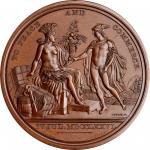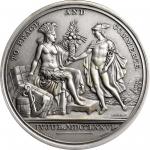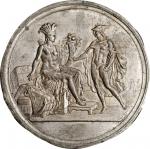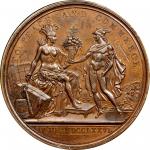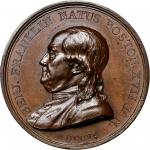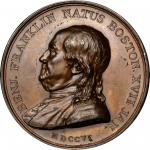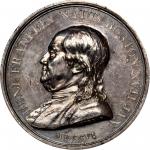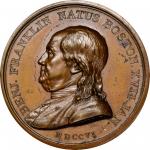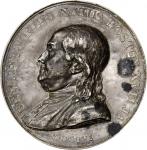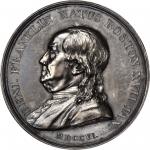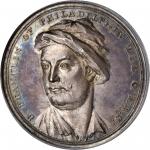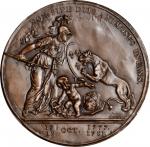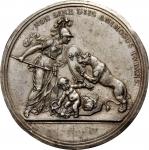1776 (1792) United States Diplomatic reverse progress cliche. Loubat-19. White metal. Original. Workshop of Augustin Dupre or Paris Mint. 68.4 x 69.2 mm. 408.8 grains. 1.4 - 1.6 mm. Choice About Uncirculated.Plain irregular edge. Backed with paper, nearly complete but for a small lustrous area near 2:00. A cliche of exceptional quality, with smooth surfaces retaining some luster and exhibiting magnificent detail throughout. Areas of irregular trimming are seen at 1:00 and 10:00, as made, and the metal was somewhat fatigued and striated at the moment of striking left of the bales below the Indian princesss lower hand. The visual appeal is spectacular. Our consignor acquired this piece from the Ford V sale because it was the prettiest of those offered.<p>This is not the adopted reverse die. The die broke at some point, probably during hardening. It was preserved by Augustin Dupre and his son Narcisse, the latter of whom sold it (among other things) to the Boston Public Library in 1888. It remains there, though the BPL has no cliche made from it. The Adams and Bentley census, which appears complete, counts six known impressions from that die. The example in the Musee dArt et dIndustrie in Saint-Entienne, France may have been made from the broken die, or the cliche itself may have just been mangled after striking; its tough to tell from the illustration on p. 126 of Trogan and Sorel. The American Numismatic Society, Massachusetts Historical Society (ex Appleton), and Smithsonian Institution (ex Stacks September 1987, lot 96) all hold examples from this die, but only two are known in private hands: this one and the one that preceded it in the Ford V sale as lot 195, now in a private New York collection.<p>The number of surviving Diplomatic Medal cliches, perhaps 19 in all, is vastly larger than the surviving total of cliches for most of Dupres American-related medals. This reflects two facts: there were two obverses and three reverses and they kept breaking during hardening, and this medal was considered of top-line importance to the American government. One can imagine William Short huddling with Dupre over these cliches and nervously approving them knowing the weight Thomas Jefferson placed upon this project. The vast majority of those cliches are today in strong institutional hands. Of the 11 held privately (one of which is unaccounted for since 1920), eight were in the Ford V sale. Just because collectors today happen to have been alive when that hoard surfaced, they should not consider these cliches as common; they are not. Even if they were, their historical importance could readily overcome it.<p><strong>A Note On Trials: Cliches, Epreuves, and Splashers </strong><p><p>The Adams Collection of Comitia Americana and related medals is uniquely enriched by several specimens of a unique form of medallic production that is known by several different names. Typically struck from a die in its earliest state, usually before hardening, these trials were called epreuves - proofs - in the original French correspondence between Dupre and Duvivier and the Founding Fathers charged with the acquisition of the medals the Continental Congress authorized. In more modern numismatic literature, they are more often called cliches or splashers, the latter term being a fair description of just how these trials were made.<p>Unhardened dies are incredibly susceptible to damage, as 18th century die steel (and modern steel today) is brittle before it is hardened by quenching. Once a die is hardened, modification becomes very difficult, so if changes need to be made, they need to be done in that fragile, unhardened state. Engravers in major mints - Paris especially - were accustomed to making soft metal impressions as something of a proofreading copy, enabling the negative die to be viewed in the positive in rough draft form. Wax impressions were liable to leave bits of wax in the interstices of design elements, thus engravers settled upon tin (usually called "white metal" in modern numismatic circles) as the best medium.<p><p>Tin melts at 450 degrees Fahrenheit, a low enough melting point to be accomplished in any small workshop. A ladle full of molten tin poured onto a surface will cool and harden fairly quickly, but remain soft long enough that a die can be easily pushed into it by hand, leaving a relatively durable impression in medal. Most often, medalists would find a piece of scrap paper - a note, a newspaper, a book page - to pour the tin atop, thus preventing their workspace from getting scorched and making the tin sheet somewhat easier to lift and trim. <p><p>These splashers were not intended to be medals, or even permanent, but simply a temporary way to display the state of the die in the positive before its devices were rendered immovable. Each was personally crafted by the engraver in his shop. In the case of the Comitia Americana medals, the epreuves made by Duvivier, Dupre, and Gatteaux were ultimately intended to be viewed and handled by themselves and those close to the process. Benjamin Franklin reviewed the epreuves of the De Fleury medal between April 20 and May 4, 1780, then made recommendations regarding the lettering in the obverse exergue that were adopted by Duvivier. He later did the same with his Libertas Americana medal, correcting a spelling error on the reverse. Engraver Augustin Dupre retained many of his splashers in his personal collection, some of which found their way into institutions in France and the United States, some of which are in the present sale.<p><p>Thomas Jefferson used cliches as a spendthrift (and lightweight) way to collect all the medals of the Comitia Americana series, assembling a set for himself and another for his Virginia countryman James Madison. As he was preparing to depart Paris in September 1789, he wrote to Madison to let him know of the boxes he was shipping, including a box of books and several crates full of Houdons John Paul Jones busts that the sitter wanted to have distributed in America. <p><p><em>I have put a collection of the proofs in tin of the medals voted by the U. S. (except two, of which the dies are in America) the medals themselves not being allowed to be taken, I desired the workmen to let me have two sets of their last proofs; for their manner is, as their work proceeds, to make impressions of it in pure tin, in order to correct &c. These proofs are in fact more delicate than the medals themselves, and the last of them shew the impressions complete. I have had them arranged in a frame, under glass &c. & beg your acceptance of them.</em><p><p>By "delicate," Jefferson did not mean fragile, but well-detailed. The modern whereabouts of these sets are unknown; it is very possible that some proportion of either of these sets are in the current sale.<p><p>Jeffersons set left Monticello in February 1798 in the hands of an enslaved man named York, who Jeffersons son-in-law and overseer, the abusive drunkard Thomas Mann Randolph, called "allmost (sic) an idiot." Randolph told Jefferson that the thief had confessed, listing off an inventory of items from Jeffersons chambers including "some impressions in lead & tin of Dies of the Medals & Coins." He continued "I have some hope of recovering the proofs of Medals (tis from the description I conclude they are out) I have traced one to a Negroe of the neighbourhood who bt. it of York but he says he has lost it." The historical record on the theft and recovery thereafter falls silent; Jefferson wrote several consecutive letters to Randolph after the receipt of this letter but never acknowledged the incident. Two different men named York were enslaved by Jefferson concurrently, one of whom was inherited from the estate of Jeffersons father-in-law in 1774 and described as a "Waterman," the other of whom was born in 1781 and labored at Monticello. Presumably the York involved here was the latter of these two, aged 17 at the time of his act of resistance against Jeffersons authority.<p><p>Today, cliches of each of the Comitia Americana medals are extremely rare, with populations in the low single digits. There is not a single issue in this format that is known to the extent of 8 or 10 pieces. Matched sets of obverse and reverse are the exception rather than the rule. Each of the survivors is an accident, a piece that was made to serve a purpose at a moment in time, not produced for long-term preservation in a cabinet. Their historicity is exceptional, as each survivor was not only in the hands of the medals engraver, but likely in the hands of Thomas Jefferson, Benjamin Franklin, David Humphreys, or a small number of others. Their rarity surpasses that of their normally struck cognates in nearly every circumstance.<p><p>With the possible exception of the Charles Senter Collection, sold at auction in 1933, no cabinet has ever included such a wide array of these historic rarities as the John Adams Collection.<p><p><p><strong>The Diplomatic Medal</strong><p>Approved by George Washington, influenced by John Adams and William Temple Franklin (grandson of Benjamin), and brought to fruition by Augustin Dupre, the United States Diplomatic medal was the pet project of Thomas Jefferson. Appointed secretary of State by President Washington on September 26, 1789, Jefferson returned home the following month from Paris, where he had been serving as Minister Plenipotentiary to the Court of Louis XVI. The following spring, in April 1790, he hatched a plan to create gifts for diplomats dispatched to the United States, just as the crowned heads of Europe gave symbols of appreciation to the ambassadors assigned to their governments. After receiving approval from President George Washington, Jefferson asked his charge daffaires in Paris, William Short, to see the project to fruition, suggesting either Duvivier or Dupre as likely authors of the medal, as they "seem to be the best workmen, perhaps the last is the best of the two."<p>Though well versed in the ways and means of diplomatic gift exchange, Jefferson reached out to William Temple Franklin for advice on the subject. Franklin answered in long form on April 27, 1790. He told Jefferson that "these presents vary as to their nature, consisting either of jewels, plate [i.e. precious metal], tapestry, porcelain, and sometimes money." He also described Benjamin Franklins gifts to the French Introductor and his assistant, the latter receiving "a rouleau of fifty Louis dors," perhaps the earliest reference to a roll of coins yet discovered.<p>Jefferson apparently wasted no time. The memorandum in the Jefferson papers entitled "Formula for American Presidents to Foreign Diplomats" appears to be the compiled notes Jefferson made after receiving William Temple Franklins letter, though the memorandum is undated. Jefferson wrote that "our present" should "consist of a gold medal of 30 lines, the metal in which will be worth about 150 dollars and a gold chain of about 850 doll[ars] value, supposing the minister to have stayed here 7 years." He may have shared the notes with Washington in some form, as Washington recorded in his diary on April 29, 1790, that he had "fixed with the Secretary of State on the present which (according to the custom of other Nations) should be made to Diplomatic characters when they return from that employment in this Country." Apparently inspired by the gift given to John Adams by The Netherlands, Washington recorded that "this was a gold Medal, suspended to a gold Chain -- in ordinary to be of the value of about 120 or 130 guineas." The enormous gold medal Adams received survives, preserved in the collection of the Massachusetts Historical Society. It was further described by Washington as "a medal & chain of the value of, in common, 150 or 180 guineas the value of which to be increased by an additional weight in the chain when they wished to mark a distinguished character," echoing much of the language of Jeffersons memorandum. "The reason why a medal & chain was fixed upon for the American present," Washington wrote, "is, that the die being once made, the medals could at any time be struck at very little cost, & the chain made by our own artisans, which (while the first should be retained as a memento) might be converted into cash."<p>The day after Washington journaled about his conversation on the subject of diplomatic gifts with his secretary of State, Jefferson filled his inkwell and wrote to both his charge daffaires in Paris, William Short, and the French ambassador, the Marquis de la Luzerne, to describe the planned medals. The idea was barely hatched, no engraver had been hired, and no gold had been acquired, yet Jefferson could not wait to describe his plan. His rush was ill-advised, however, as no medals would be struck for nearly two years.<p>Jeffersons casual notes mention three potential recipients of these gold medals for diplomats, namely the Marquis de la Luzerne, the Comte de Moustier, and "Old Mr. Van Berkel" of The Netherlands. Though William Short later recorded receiving just two gold medals for distribution, Adams and Bentley (<em>Comitia Americana and Related Medals,</em> 2007) used Jeffersons early memo as evidence that three specimens were struck (one for each of the above named potential recipients). Presumably, given the careful penny-pinching nature of the United States government at this point, as well as the borderline obsessive bookkeeping of Jefferson, had more than two been struck in gold, there would be a financial paper trail. Adams and Bentley make a further assertion that there were potentially four gold medals struck, basing this on a May 1793 missive from Jefferson to Washington that included a draft of a letter from Jefferson to French ambassador Jean-Baptiste Ternant, to which was appended a version of the previously described Jefferson memorandum. The language of that appendix gave a ballpark idea of the potential weight of a medal for Ternant if one was to be struck, giving his length of service, in Jeffersons words, as "1 3/4 (say 2)," clearly a back-of-the-envelope style arithmetic intended to show Washington the potential costs involved. Alas, the paperwork that has survived from Jefferson, Washington, and William Short appears to indicate the sum total of two gold specimens of the Diplomatic Medal were struck, no more. The invoice William Short received on January 31, 1792, included charges for two "medailles dor" and the letter Short sent to Jefferson on February 8, 1792, noted plainly, "I had only two gold medals struck." Those two gold medals, given to the Frenchmen Luzerne and de Moustier, are untraced, almost certainly lost in the upheaval of the French Revolution.<p>The same February 8 letter from Short to Jefferson also noted "the six of bronze will await your orders," the same six bronze medals that were listed on the January 31 invoice. Of those six, four appear to have survived. The French-American numismatist and geologist Jules Marcou reported that "Jacques E. Gatteaux, son of the distinguished engraver, exhibited to him two copies in bronze" in 1867, but both were destroyed, along with the rest of Gatteauxs collection, in the fires that engulfed Paris in May 1871. Marcou also saw a bronze specimen in the possession of Augustin Dupres son Narcisse; the Dupre specimen has not been specifically traced, but it may be the example that William Sumner Appleton later owned, as Appleton was instrumental in acquiring other materials from Dupre for the Boston Public Library, including drawings, white metal cliches, and even a set of original dies for the Diplomatic Medal.<p><strong>Obverse: </strong>The first version of the Great Seal of the United States ever executed in medallic form, correctly showing the olive branch of peace at dexter (eagles right) and the arrows of war at sinister (eagles left, viewers right). The eagle holds a banner inscribed with the national motto E PLURIBUS UNUM in his beak and an escutcheon or shield is displayed on his breast. A glory of 13 stars is atop the obverse, and the legend THE UNITED STATES OF AMERICA surrounds the arms at the periphery. <p><strong>Reverse:</strong> An allegory of America, in her common guise as a Native American princess, holds a cornucopia or horn of plenty and gestures to bundles and a hogshead beside an anchor. She is approached by Mercury as Commerce, holding his caduceus. A ship representing Atlantic commerce and interactions with Europe is in his background. The legend TO PEACE AND COMMERCE is appropriate to the scene; the date July 4, 1776 is rendered in Roman numerals in the exergue.<p><p><p><p><p><p><p><p>From the John W. Adams Collection. Acquired from Stack’s sale of the John J. Ford, Jr. Collection, Part V, October 2004, lot 194. Earlier, “found in an old safety deposit box before 1953, believed ex Wayte Raymond.”

